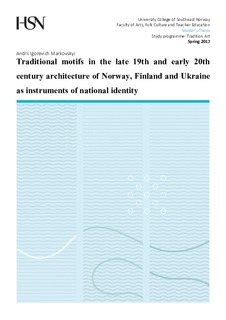Traditional motifs in the late 19th and early 20th century architecture of Norway, Finland and Ukraine as instruments of national identity
Master thesis
Permanent lenke
http://hdl.handle.net/11250/2459666Utgivelsesdato
2017Metadata
Vis full innførselSamlinger
Sammendrag
The work consists from theoretical research, which key problem is a comparative
analysis of using of "traditional motifs" in the architecture at the turn of the 19th and
20th centuries in eastern and northern Europe (on the example of Ukraine, Norway and
Finland), as a means of national identity in the struggle for independence and building
of national states; and the practical part, which is implemented as a conceptual project
of Ukrainian cultural center in Norway.
A key hypothesis of theoretical part of the work is that the architects from different
countries and regions that do not have close contacts between them, in similar socioeconomic
conditions (the struggle for independence on a background of construction
boom and economic growth at boundary of centuries) used the same strategies (focus
on the "invented" tradition) to achieve similar goals.
The main aim of the practical part of the work is to study the possibilities of using
traditional motifs in modern architectural design and perspective ways of their
realization.
